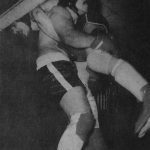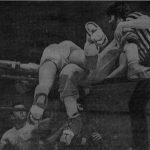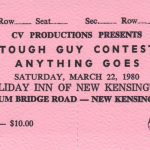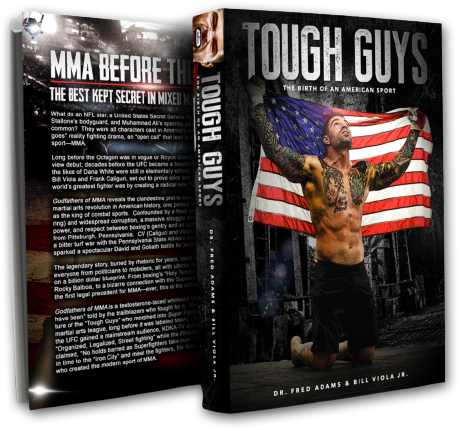Who is the Father of MMA?
Who’s your daddy? Mixed martial arts edition:
Alexander Cartwright, James Naismith and Walter Camp all share a similar rite of passage, each has been honored as the “father” of their respective sports: Baseball, Basketball and Football. For all intents and purposes history credits them with invention, although each sport evolved incrementally from some inspiration or another. While there may be scholarly debate about who, what, when, where and how each sport actually was conceived, history proves that the masterminds behind the original “rules and regulations” determine the birth of a sport, and with it the recognition of its original author, aka “the father.”
 The journey towards mainstream status for every sport has endured long and winding roads, but each trailblazer took that same very defining first step—RULES. It’s the creation of rules that distinguishes a game from simply goofing off and sport from spectacle. While rules have certainly changed over the past century, the essence of each major sport is steeped in tradition. Basketball, football, and baseball can trace their roots back to a pioneer who drafted a blueprint in an effort to standardize competition. Embodied by awards that bear their namesake, the legacy of Cartwright, Naismith, and Camp are intact, but who is the father of MMA? Who penned the holy grail of MMA rules?
The journey towards mainstream status for every sport has endured long and winding roads, but each trailblazer took that same very defining first step—RULES. It’s the creation of rules that distinguishes a game from simply goofing off and sport from spectacle. While rules have certainly changed over the past century, the essence of each major sport is steeped in tradition. Basketball, football, and baseball can trace their roots back to a pioneer who drafted a blueprint in an effort to standardize competition. Embodied by awards that bear their namesake, the legacy of Cartwright, Naismith, and Camp are intact, but who is the father of MMA? Who penned the holy grail of MMA rules?
The default response isn’t an individual at all but rather, “The UFC of course.” The nonchalant reaction bundles Rorion Gracie, Art Davie, Campbell McLaren, Bob Meyrowitz, Dana White and a host of others into a single entity so you don’t have to pinpoint exactly when the NHB became MMA. Some would argue that pioneers like Jeff Blatnik, Larry Hazzard, John McCarthy, and Howard Petchler, who all had a hand in influencing modern MMA rules, should be in the conversation. Each deserves a placard in the Hall of Fame, but unfortunately those rules were not the originals. CV owns the rights whether folks know it or not.
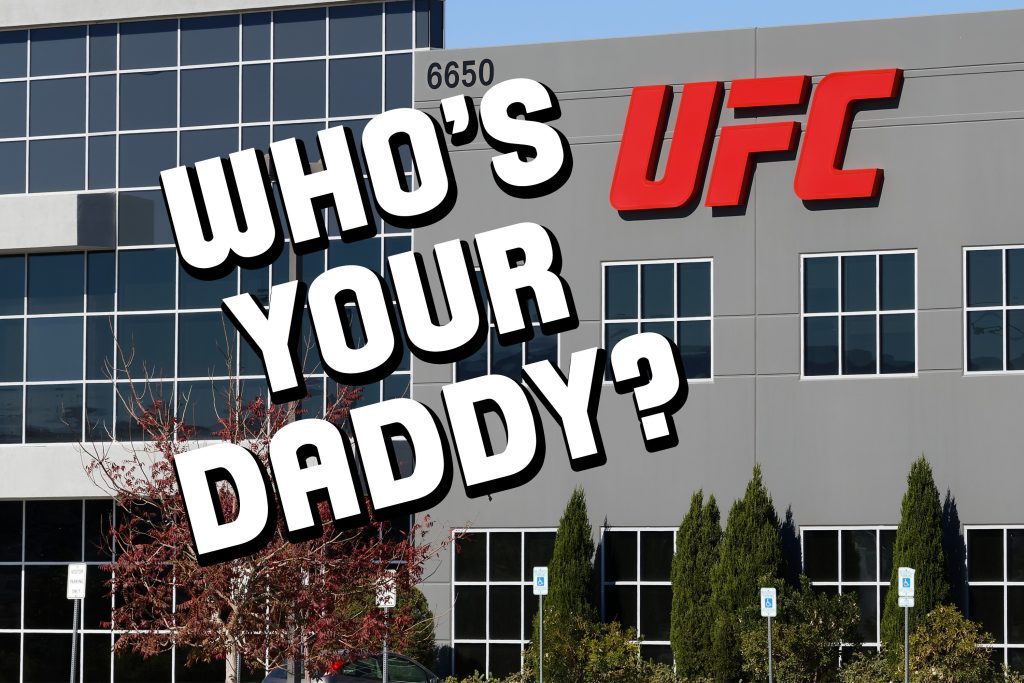
When my dad first put pen to paper so many years ago he had a vivid dream. As successful as mixed martial arts has become, to him, MMA is as brilliant today as it was supposed to be in 1979. It’s come a long way since the Holiday Inn in New Kensington, but one thing remains the same; my father, Frank, and the original “Tough Guys” and Super Fighters will always and forever be the undisputed Godfathers of an American sport.
While the UFC popularized the idea of MMA, the “sport” was created a decade earlier (MMA’s best kept secret). CV Productions provided the blueprint for a multi-billion dollar business in 1979; the first league of its kind with no pay-per-view or the internet to spread their message. The Super Fighters revolution was repressed, now passed off as mere urban legend, but it’s time to look past the fairy tale version you’ve been brainwashed to believe—UFC’s Maiden Voyage.
Art Davie thought he had entered uncharted waters in 1993 when he created the Ultimate Fighting Championship, but another ship set sail years before him. Davie planted his flag in Denver, Colorado thinking he had discovered new land, but in reality MMA’s story began in Pittsburgh, Pennsylvania more than a decade earlier. It’s not up for debate; there is overwhelming evidence that a UFC-esque promotion thrived before Rorion Gracie and Art Davie collaborated. CV Productions was a premonition of the Zuffa era, built as sport from the ground up, while UFC 1 was devised as a spectacle, slowly transforming to sport over time. The former isolated in Pennsylvania, the latter seen in every major market in America. One forgotten, the other larger than life.
While Davie, a true innovator, certainly pitched the idea of cage fighting and popularized it on television, his vision “There are no rules” was a far cry from anything that resembled sport. His version would eventually morph into a billion dollar behemoth, but it too had a precursor. Yes, he co-created the UFC (the most famous 3 letters in combat sports) but he wasn’t the first to “package” MMA. It may be hard to fathom that sport existed before the UFC, but it did. Art Davie and Rorion Gracie were the first to introduce modern MMA to the “world” (via pay-per-view) but remain the runner up in “America.”
Most media outlets tell us, “Mixed martial arts competitions were introduced in the United States with the first Ultimate Fighting Championship (UFC) in 1993.” This just isn’t true; a major milestone yes, but a major misnomer. They, the press, got it wrong in ‘93 and have been wearing blinders ever since. A more accurate description might have been, no-holds-barred competitions were introduced in the United States with the first UFC but the modern sport of mixed martial began under the banner of CV Productions. Too late, once the ripple effect set in (print, reprint, reprint) the UFC became the first of its kind. Positive or negative press, the public is prone to believe what news they hear first. Ask any politician who’s been on the wrong end of a juicy scandal; truth becomes relative depending which way the press leans. It’s equally hard to buck that trend if you are an inventor or explorer playing catch up.
The perception of the UFC and CV Productions is very much in line with Christopher Columbus and Leif Eriksson. While the Vikings didn’t have a clever rhyme, Columbus did, sailing the ocean blue in 1492. The Ultimate Fighting Championship’s ploy of course was shock and awe, broadcast live and in bloody color. UFC, like Columbus, won the media’s attention and was accepted into an exclusive club with “lifetime” membership—pop culture. The New World may have been discovered 500 years before Columbus was born, but once America makes up her mind she is stubborn.
History does seem to iron itself out, but first impressions still carry a lot of weight. What’s right is right and President Lyndon Johnson declared October 9th to be Leif Eriksson Day, just a few days earlier than Columbus Day observed on the 12th. However, unless you’re Norwegian, Columbus still takes the first place for being second. CV Productions is yet to get its official proclamation, but their day is coming.
Today, CV Production’s “anything goes” creation has evolved into one of the fastest growing sports in the world, albeit under the auspices of the Ultimate Fighting Championships. Nearly thirty years before the UFC garnered real mainstream acceptance, CV set up shop as the first mixed martial arts company in American history. Although enshrined at Heinz History Center in association with the Smithsonian Institution, you’ve likely never heard of them—until now. MMA is the sport of the 21st century: WOW Promotions popularized it, SEG Entertainment refined it, Zuffa LLC monetized it, but CV Productions created it. This is your exclusive ticket to travel back in time and relive the epic journey of the Tough Guys.
RULES: In the words of Bill Viola Sr.
In September of 1979, Viola and Caliguri hatched the idea of a unique competition, a new sport, and they recall the genesis of the project with a fondness daVinci might express about his early sketches of the Mona Lisa. Bill recalls, “We were in Denny’s Restaurant in Monroeville, our unofficial meeting place at night after the dojos closed, discussing our upcoming kickboxing events.
“Every time we hung up a kickboxing poster, some smart ass would remark, ‘I know so-and-so who could kick the shit out of that karate guy.’ But no one ever challenged us personally.” He says with a laugh, “Taking Frank with me was like Wyatt Earp taking Doc Holliday along. Punch first and ask questions later. It was exhausting to hear these guys with beer muscles claim that they or their buddies were the meanest, strongest, biggest bullies on the block. It was a constant verbal mishmash, and we really wanted to shut these egomaniacs up.
“As we joked about those blowhards, a frequent fantasy argument arose: who would really win if Muhammad Ali would have fought Bruce Lee? Who would win if Bruce Lee fought Bruno Sammartino? Which fighting discipline would trump all others? Better yet, what combination of fighting skills would prevail? We’d had this conversation a hundred times before, but this time it went a step further. Spontaneously, the idea came to us: Let’s really prove it! Throw them all into the ring together and see who wins. Neither of us was kidding. It was easier said than done, but we liked the challenge.
“Of course we couldn’t expect people of the stature of Ali or Sammartino to participate, but what if we started with lesser known fighters? What if we held an ‘open’ competition where every tough SOB in the country had a chance to prove just how ‘bad’ they really were? What if we somehow made it safe for competitors?” The ‘what if’s’ quickly became ‘how to’s.’
“We could implement a hybrid set of rules and regulations encompassing all combat sports. We would let any fighter choose and execute his own skill set. It would be anything goes. Let boxers box, wrestlers wrestle, street fighters brawl, and may the best man win. It would become what is known today as ‘mixed martial arts.’ It sounded like a cockamamie idea reminiscent of Enter The Dragon, but we knew if it was done right, we might just be able to pull it off.” With the dual mindset of promoters and the experience of seasoned fighters, CV Productions, Inc. was born; America’s first mixed martial arts promotional company. Thomas Edison once said that genius is one-percent inspiration and ninety-nine-percent perspiration. The story of “mixing” martial arts from its inception bears out that aphorism.
I was a teacher and ‘Science is the systematic enterprise that builds and organizes knowledge.’ My job was to write a set of rules that were flexible enough to accommodate all the possible fighting styles yet restrictive enough to keep people from being crippled or even killed in the ring. The result was fifty or sixty pages of notes and an eventual 11 page set that anticipated many of those in place today in MMA competition.”
“I had to devise a blend of rules that gave fighters from every background a chance to win and at the same time make sure nobody got maimed. For the sport to be sustainable, it needed structure and a launching pad. It was a daunting task, exploring each fighting art. It began as an empirical study, interviewing expert trainers, teachers and coaches.
“After school I spent time with John Potanko the wrestling coach at East Allegheny. He was a veteran of the Military Police, so he incorporated an old school way of thinking when it came to hand-to-hand combat and how to subdue the enemy. I used to pick his brain and try out ideas; it was a trip. I had worked out and shared ideas with Pete Saylo, a Judo teacher in North Versailles.
“Roger Miller was our resident guru for close quarter combat and a regular at our open house nights at the dojo. He was something of a ronin, a masterless warrior who traveled around the Orient gaining a vast knowledge of joint locks, pressure points during his stint in the military. He brought some complex techniques to the table.
“Wednesday nights at my dojo was a showcase of masters who shared their knowledge. Sensei Joe Hedderman would bring a group of jiu-jitsu students to train; they were some of the roughest guys in town. They were experts in ground fighting and submissions. It was mutual respect, and we all learned a lot.”
Viola continues, “I went down the list; Boxing, Jujitsu, on and on. The notes became a tangled web of what would work within the confines of each individual sport and bridge the gaps between them; boxing, wrestling, karate, judo and others. It was a pragmatic approach to the science of combat. The workload was so intense I took a sabbatical from teaching. I risked my career for the potential of MMA, and what resulted was ‘the prototype,’ the rulebook that set the stage for the future.”
“We felt in order to be considered a sport, enforceable rules and regulations were essential. My general guidelines were set; fighters could win by knockout, technical knockout, submission or decision.” CV’s Judges adapted the “10-point must system” to include ground fighting in the scoring system. Striking, throwing, grappling, punching, kicking, and ground fighting, were all legal within prescribed parameters. It would become the first codified set of MMA rules.
The Valley News-Dispatch would report, “Everyone knows there are no rules in street fighting and the only reason the fight ends is that the police or ambulance arrives.” Viola says, “That made for good copy, but our rules stipulated illegal fouls, including ‘biting, head butts; strikes, punches or kicks to the groin; and strikes, punches or kicks to the spine.’ We didn’t want to give anyone a reason to boycott our idea, so we eliminated the most dangerous techniques that could easily injure competitors.”
As sports editor Jim Isler put it, “The bout proper consists of three-two minute rounds of catch-as-catch-can action with elements of boxing, wrestling, karate judo and mayhem mixed in.” Viola jokes, “We left the rest up to the imagination. It was that unknown element that had fight fans salivating.”
“Our ads read: ‘Fighting Tactics: The martial arts way of fighting as it’s done in the Orient. Now here in the U.S.! Illegal tactics will be barred. Protective gear will be used.’” CV incorporated a light weight foam padded glove manufactured by Jhoon Rhee. The use of open-fingered gloves would allow for effective grappling and wrestling techniques and still offer protection of the fighters while striking and punching. It was an innovative compromise. Fighters would also be required to wear a similar foot pad that fit like a boot and left an open area for the bare foot.”

It took the UFC years to implement open fingered gloves
In order to satisfy the wrestlers and grapplers in the competition, points were awarded for ground control in the form of a pin or victory by submission. Viola instructed the judges to give credit for take downs and throws the same way they would score a damaging punch or kick. After a fighter had shown superior grappling by controlling an opponent for a period of time on the ground (or lack of activity) the fighters would break and resume from a standing position. Passivity remains a grey area in the modern MMA, when or when not to stand up a fighter.
Viola adds, “I had some of my students volunteer to test the rules in mock-up matches. The practice bouts went smoothly, and we were ready to move forward.”
Get the entire story: Tough Guys available on Amazon.
 Looking back…
Looking back…
Ultimate fighting had made a lot of noise in the mid-1990s, but in a way Pennsylvania was prepared for the invasion before the UFC was even invented. The obscure language from the 1983 “Tough Guy Law” made its way into the 1992 Pennsylvania Boxing Act: Prohibited competitions – 5 Pa. Cons. Stat. § 1701:
“(a) OFFENSE DEFINED.– A person commits a misdemeanor of the first degree if he promotes, sponsors or participates in any manner in the staging of or the conduct of any tough guy contest.
(c) DEFINITION.– As used in this section, the term “tough guy contest” means any competition which involves any physical contact bout between two or more individuals who attempt to knock out the opponent by employing boxing, wrestling, martial arts tactics, kicking, choking or other techniques or any combination thereof.”

“That is a simple definition of mixed martial arts; no ifs ands or buts about it,” explains Viola. “Call it what you want: tough guy, extreme fighting, super fighting, or MMA but if it looks like a duck and quacks like a duck, well you know the rest. It’s all the same concept–same theory. The timing is what was really unbelievable. The Boxing Act in ‘92 was equipped with a ban against mixed martial arts before the rest of the country even knew what the UFC was (1993). It’s a total coincidence but still historic.”
Viola continues, “New York began urging its neighbors to ban the sport, but Pennsylvania didn’t have to lift a finger. When the PSAC was approached with the prospect of Ultimate Fighting in 1997, the commission rejected the request citing the ‘Tough Guy Law’ (now part of the Athletic Code) as the basis. Fair enough. Their action affirmed the existence of mixed martial arts in 1980. For us, it was a catch-22; the ban on mixed martial arts remained intact, but at the same time it proved to all the naysayers that MMA did in fact exist before the UFC.
“We figured if a company like the UFC couldn’t gain any ground in Harrisburg, it may never make a comeback here. Ten years later the PSAC opened the floor for discussion. The finish line was in sight, but we weren’t in the race anymore.”
As the Commonwealth inched closer to its first sanctioned MMA fight of the 2000s, the “Tough Guy Law” made headlines once again in 2008. In a highly publicized case the PSAC targeted “Celebrity Boxing” promoter Damon Feldman (infamous for staging outrageous “D-List” boxing matches with the likes of Jose Canseco, Rodney King, and Danny Bonaduce) with the “Tough Guy Law.” Viola’s response, “Say what? Now they single out Toughman boxing after all these years? Give me a break.” The “Tough Guy Law” continues to be somewhat of an anomaly, used by certain special interests as a pawn.
Interestingly enough, boxing journalist Charles Jay has reported that Greg Sirb (PSAC Executive Director) actually participated in similar “tough guy variations to benefit charity” years earlier. Some people have cried favoritism. Nonetheless the PSAC sought an injunction against Feldman’s promotions. The judge in the case ruled that in order for a bout to be categorized as a “tough guy competition,” the participants must employ multiple combat techniques, not just boxing. In other words, it applies only to mixed martial arts.
Viola elaborates, “You see, we didn’t use the term ‘mixed martial arts’ and neither did the UFC initially; it was tough guy (later Super Fighters) in the ‘80s and ultimate fighting in the ‘90s. The only thing that has changed since 1979 is the name. The branding [MMA] is merely a technicality, but it has since opened the door of ambiguity in the eyes of some lawmakers. There shouldn’t be, it’s pretty clear what the law is referring to, but its interpretation has played a significant role here.”
“The PSAC lost that battle in court, and in some strange way it felt like a victory for us,” says Viola. “Our service mark was upheld in court as MMA! I never thought in a million years I would cheer for that law. It certainly wasn’t how we planned validation, but it was a form of poetic justice.”
Mari A. Schaefer, Staff Writer for the Philadelphia Inquirer, reports that the commission then filed a complaint with the Attorney General’s office. Soon an investigation was launched into the “entertainment” type bouts. As for Feldman, his win in court was short lived as the PSAC found new violations to shut him down (charges of promoting without a valid license and fixing fights surfaced).
Viola adds, “Like Art Dore, Feldman was selling a gimmick to make easy money by putting a new spin on an old sport. The old guard targeted MMA specifically, that’s why the law didn’t hold up in court to stop these boxing contests. The legislation has been so convoluted by smoke and mirrors over the years, I am not sure if the current Commissioners are aware of the law’s original intention. Yes, it became part of the “boxing” code, but if you weren’t around in 1979, it’s hard to grasp that it was directly aimed at mixed martial arts. If they want to draft new legislation to specifically ban toughman [Celebrity Boxing etc.], like they should have in the ‘80s, by all means do so. That is something the state and I agree on; toughman boxing has never been safe.”
When they regulated MMA in the State of Pennsylvania the “Tough Guy Law” remained on the books. That is a contradiction to say the least, especially since a judge already decided it applied to combined fighting (mixed martial arts) not boxing.
It’s a confusing sequence of events that warrants a quick recap. MMA was banned in Pennsylvania by the “Tough Guy Law” in 1983. The PSAC has since regulated the sport deeming the Tough Guy “concept” legal, but technically according to Pennsylvania Statute, the definition of the competition is illegal. Mixed Martial Arts are only permitted if said activity is under the thumb of the PSAC. When any event challenges their authority, the “Tough Guy Law” is dusted off as a catchall defense and they will shut you down. Things that make you say hmm.
“I am glad the sport is regulated and thriving,” says Viola. “That was our goal with the ‘Super Fighters’. The PSAC is doing a great job with it now. What irks me is that they still cling to an archaic law that was drafted with ulterior motives. It makes absolutely no sense that the state still describes mixed martial arts competition as a crime [misdemeanor]. Tough Guy is MMA and MMA is Tough Guy in Pennsylvania and it’s time the state accepts that fact. The old ‘Toughman’ boxing smokescreen has been exposed, and the masterminds behind it are long gone. Maybe nobody else cares, but for me it’s a matter of principle. My hypocrisy only goes so far [laughs]. But it is time for the truth to be told about the ‘Tough Guy Law.’ It needs to be amended and wiped off the books.”
Viola explains, “In hindsight I wish we would have sued the State of Pennsylvania, but the deck was stacked against us. We were young and ultimately Frank and I couldn’t jeopardize our families and livelihood for a losing battle. We had ‘inside’ information that the political machine had made its final decision and no argument would change their mind. We realized that even if we won a court battle, there would be appeals and more appeals. The legal bills would have been in excess of a million dollars to take it to the highest levels and still no guarantee they would ever see things our way.
“I am watching the UFC lawsuit against New York very closely, especially since we’ve been in their shoes. As Yogi Berra once put it, ‘It’s déjà vu all over again.‘”
On November 15th 2011, Zuffa LLC officially filed a class action lawsuit against the state of New York. “We didn’t have a bank roll like the UFC does today, but even they waited over ten years to take it to court.”
The Unconsolidated Laws of the State of New York, Title 25, Chapter 1. § 8905-a(2) banned professional mixed martial arts competition in the Empire State in February 1997. Since that time, the media has adopted the false notion that, New York is the first state to ban mixed martial arts. While it was certainly a widely publicized case and first prominent legislation of the UFC era, it was not government’s first intervention; we know that The General Assembly of Pennsylvania banned mixed martial arts style events in Pennsylvania over a decade and a half earlier.
Pennsylvania politicians took unprecedented legal action against CV Productions and the sport of MMA. Viola adds, “MMA is now perfectly legal in nearly every state. Their Promotions have graced most major sporting venues across the country; except Madison Square Garden. Certain facets of the New York legislature remain staunch opponents of MMA. Some say it’s a deliberate blockade by the Culinary Union and their lobbying efforts to spite the Fertitta family and their “non-union” owned Station Casinos, while others see New York as symbolic road block, the final stronghold for boxing. Either way it’s been a media circus that has led to the UFC finally taking New York to court. And why not, they have the money to do so now; win or lose.” Viola Jr. adds, “I wish my dad and Frank had that luxury back then, the entire course of MMA could have been altered.”
UFC is challenging the 1997 law, citing that it is unconstitutional under the First Amendment and a violation of the 14th Amendment’s Equal Protection Clause because New York allows other contact sports (hockey, boxing, rodeo, football etc.) that are arguably as dangerous as MMA. They also assert that the current ban is a violation of the due process clause, because it bans live professional MMA, but not amateur events or televised events.
The suit has been filed by New York University School of Law Professor Barry Friedman, who takes a novel approach to the issue:
“Despite sincere legislative efforts, the ban remains in place based on a flawed assessment of the sport’s supposedly ’violent message.’ This rationale is a patent violation of the First Amendment. In live events, fighters showcase their talents, communicate their convictions, show respect for their opponents and the art and tradition of MMA, and convey the importance of discipline, training and hard work. They also entertain their fans. Not only does the law prohibit live events, but as it is written it purports to ban other speech including media broadcasts and coverage of professional MMA. It is ironic that New York — in many ways the home of free expression, the global media, and the art world — would deny someone his or her fundamental freedom of expression. The Ban is contrary to what New York is all about. There is no legal basis for this unconstitutional ban to persist.”
Bill Viola says, “I looked over the complaint filed by the UFC, and I recognized Jennifer Santiago’s name [one of the plaintiffs]. It’s amazing how closely knit the martial arts community is. I remember her competing at karate tournaments when she was a kid. She became a star in the WCL (Chuck Norris’s World Combat League). It’s a small world. Jennifer’s father Hector was the coach of the Metro All-Star karate team. My son was a member of the team in the early 1990s. She was an awesome fighter. I am glad she is standing up for what she believes in.”
In March 2012, New York Attorney General Eric Schneiderman stated that, “Indeed, increased legislative and regulatory attention to sports such as boxing, football, and hockey may well be coming.” It begs the question; does this open the door for New York to consider a hockey fight an assault or an intentional helmet-to-helmet football hit a chargeable offense? Viola says, “It’s a slippery slope that the entire American sports scene is bracing for. Concussions and other head injuries are a ‘hot button’ issue; all contact sports are now under the watchful eye of the medical community, politicians, and moms and dads everywhere.” As we move into uncharted waters, a large contingency of hard core fans fear the worst, sissified sports.”
Finally, New York lifted its 19-year ban on MMA March 22nd 2016 under the hand of Governor Andrew Cuomo (the last state to do so). The New York Assembly voted 113-25 in favor of the bill to legalize the sport empowering the New York Athletic Commission with full jurisdiction over MMA including a 8.5% tax on gate and an a 3% tax on broadcasting rights sold.
An Ultimate Irony
On February 27, 1998 Bill Viola Jr. was honored by University of Pittsburgh Chancellor Mark Nordenberg as an outstanding scholar. The Honors Convocation was held at Soldiers and Sailors Memorial Hall, a landmark in Pittsburgh. The distinguished guest speaker was The Honorable Richard Thornburgh. Yes, that is former Governor Thornburgh who gave his executive approval, enacting the “Tough Guy Law” in 1983.
Viola, Sr. recalls, “Dr. Sam Conte was the University Registrar and my cousin through marriage. He was a friend and colleague of Governor Thornburgh (an alumnus of Pitt Law School).” It was Thornburgh’s signature that officially outlawed mixed martial arts, the first action of its kind in America fifteen years earlier.
Viola, Jr. jokes, “He effectively put the final nail in CV Productions’ coffin, although I’m sure he wasn’t aware of the back story. He just accepted a bill that unanimously passed the House and Senate. Pennsylvania lawmakers were never given accurate information, so in essence they acted in what they saw to be in the best interest of the Commonwealth as misguided as it was.”
Viola, Sr. adds, “At the end of the awards ceremony, Thornburgh sought out my cousin to catch up. Sam immediately introduced us to the Governor who congratulated my son. There were absolutely no hard feelings; he didn’t write that law. He just happened to be in office when it crossed his desk. It is ironic that he would honor my son and take a picture with him, though. There we were, all of us joking around and having a good time. He had moved on from Pennsylvania politics and we had come to terms with the success of the sport we created. It was an interesting moment, one I won’t forget.
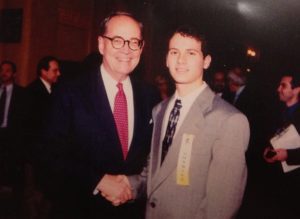
The Honorable Richard Thornburgh and Bill Viola Jr.
“My son was planning on attending law school after graduation, but after that day he decided become a promoter. I guess it is in his blood and I couldn’t stop him. He began laying the groundwork for his own production company [Kumite Classic] the following year.”
Viola, Jr., adds, “My dad always jokes, ‘Where do you think you would be if we weren’t shut down?’ Of course I can’t help but imagine ruling over an MMA kingdom [laughs] but I’m content knowing that my dad and Frank will go down in history as the men responsible for inventing a new sport in America. I’m proud to be a part of that legacy.”
Read more about the Zuffa Myth: Dana Doubleday


